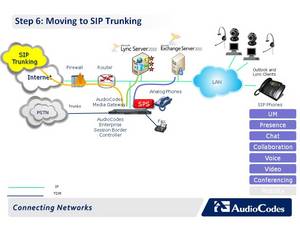Moving to SIP Trunking
 Over the last few step in our eight-step guide to unified communications, we’ve introduce da lot of new capabilities and functionality that will not only make sure the deployment is a success, it will drive end users to demand access to the new tools.
Over the last few step in our eight-step guide to unified communications, we’ve introduce da lot of new capabilities and functionality that will not only make sure the deployment is a success, it will drive end users to demand access to the new tools.
Now it’s time to start making this deployment just as exciting to management – and if there’s one thing the C-suite can behind, it’s the idea of saving serious money. To make that happen, it’s time to introduce SIP trunking and downsizing or eliminating traditional PSTN trunks. In reality, this is a step you can take at an earlier point, should you choose to do so, or should getting those cost savings on the table earlier be of prime importance for customers.
Getting started is as simple as upgrading the Mediant 1000 gateway we introduced way back at the beginning of this guide to add Enterprise Session Border Controller (E-SBC) capabilities. If you’re done your planning right throughout the process, this should be as simple as adding software key on the gateway, but in some circumstances, you may have to swap out a module or two. Our team of AudioCodes sales engineers would be happy to help determine the right path forward for any particular customer, so please call on them should you have any questions.
Once E-SBC features are turned on, SIP trunks can be brought in, you can start routing calls through the new trunk to E-SBC, which will reformat incoming SIP messages to be compatible with Lync as well as making sure traffic is safe and secure.
With that, much of the traffic can be moved over to the SIP trunk and you can look at downsizing PSTN trunks. In some cases, you’ll be able to PSTN outright, but many businesses like to keep a few lines around for survivability purposes or for local access numbers.
At this point, the job is pretty much done at the headquarters location. The blanks remaining to be filled in: remote offices/branch offices, and mobility. We’ll tackle those two pieces of the puzzle in the remaining two steps.
Continue reading to Step 7 >>
-thumb-autox90-10361.jpg)






Leave a comment